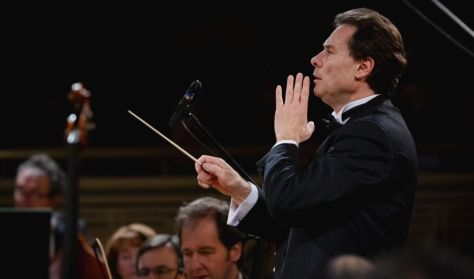
Beethoven in the Park
Hungarian National Philharmonic concerts in Martonvásár

Hungarian National Philharmonic concerts in Martonvásár
Ön egy múltbeli eseményre keresett rá. Kérjük, válogasson aktuális kínálatunkból a Jegy.hu keresőjében!
Last event date: Saturday, July 19 2025 7:00PM
Saturday, 5 July 2025, 7 pm (rain data: Sunday, 6 July)
Program
Piano Concerto No. 4 in G major, Op. 58
Mass in C major, Op. 86
Ágnes Kristófi soprano
Gabriella Busa alto
Flórián Körmendy tenor
Zsombor Cserményi bass
Gergely Kovács piano
Hungarian National Philharmonic Orchestra
Hungarian National Choir (choirmaster: Csaba Somos)
conductor: Csaba Somos
The opening night of this year’s Beethoven in the Park series features two highly significant works by the great composer, both of which reflect a master seeking new paths. The Piano Concerto in G major (1805/1806) establishes a new departure in the history of the genre with its profound seriousness and unconventional approach in terms of form, which switches the emphasis from virtuosic brilliance to a more confessional tone. On one hand, the “Kismarton” Mass (1807) illustrates the composer’s Hungarian ties as it was commissioned by Prince Nikolaus II Eszterházy for his wife’s name day. In contrast to previous settings of church masses to music, this work replaces a large number of smaller elements with longer, cohesive sections, assigning greater importance in the method of composition to thematic connections and direct expression. For this concert, the Hungarian National Philharmonic Orchestra and Choir will be conducted by the latter’s choirmaster, Csaba Somos, while the soloist forthe concerto will be a worthy representative of the young generation of Hungarian pianists in Gergely Kovács, and the vocal solos of the mass will be performed by Ágnes Kristófi, Gabriella Busa, Flórián Körmendy and Zsombor Cserményi, all outstanding members of the Hungarian National Choir.
Saturday, 12 July 2025, 7 pm (rain date: Sunday, July 13)
Program
Coriolan Overture, Op. 62
Romance No. 2 in F major, Op. 50
Romance No. 1 in G major, Op. 40
Symphony No. 4 in B-flat major, Op. 60
Attila Falvay violin
Hungarian National Philharmonic Orchestra
conductor: György Vashegyi
Egmont, Prometheus and Coriolan: Beethoven often paid tribute to humanity’s noteworthy rebels as he perhaps saw them as kindred spirits. You might think that the Corolian Overture (1807) was written for the Shakespeare drama of the same name, but this wildly passionate and tempestuous work was instead intended as introductory music to a tragedy written by a contemporary of Beethoven’s, Heinrich Joseph von Collin. Following the dark mood of the overture, the Romances in F and G major (1798, 1801), composed for solo violin and orchestra, offer up a striking contrast. In both works, Beethoven shows us his tender side, with the atmosphere of the compositions characterised by moderate tempos, a contemplative tranquility and an occasionally elevated tone reminiscent of prayer. The violin parts do not demand virtuosity and are much more song-like in nature. According to Schumann, Symphony No. 4 (1806) is “a Greek maiden between two Nordic titans”, where the latter are the Third and the Fifth Symphonies. A defining element of the work is the energy and cheerfulness of its outer movements, along with its lively character and brisk rhythms. The conductor for this concert is the general music director of the Hungarian National Philharmonic, György Vashegyi, who is remarkably at home in the world of Viennese classical music. In performing the violin solos in the two romances, the orchestra’s concertmaster Attila Falvay bids farewell after two decades.
Saturday, 19 July 2025, 7 pm (rain date: Sunday, July 20)
Program
Symphony No. 6 in F major („Pastorale”), Op. 68
Symphony No. 8 in F major, Op. 93
Hungarian National Philharmonic Orchestra
conductor: Róbert Farkas
The closing evening of Beethoven in the Park pairs two symphonies. Symphony No 6 (1808) is rare in that it was Beethoven himself who gave it the distinguishing title of “Pastoral”, alluding to the harmony between Man and Nature. The composition is gentle and cheerful in tone, while its attempt to depict certain scenes is a revolutionary innovation that foreshadows programme music, according to which every movement has its own theme: the first evokes the joy of the man arriving in the countryside, the second is a scene by a stream with singing birds, the third envisions a lively peasant dance, the fourth paints a frighteningly authentic audible image of the sudden outbreak of a storm, while the closing fifth movement (because the symphony breaks the mould by comprising five movements) is a song of gratitude that the storm has passed. The untitled Symphony No. 8 (1812) is, like the Sixth, in F major and – akin to the Second and Fourth Symphonies – celebrated for its cheerfulness, lively momentum, rich contrasts, energy and rhythmic vitality. Taking to the podium for the concert, Róbert Farkas is the outstanding representative of the middle generation of Hungarian conductors. Following his studies in Hungary and Berlin, he achieved many years of success primarily abroad – above all in Germany – and has been the chief conductor MÁV Symphony Orchestra sinceSeptember 2021.
A Monte Cristo grófja egy igazi, nagy ívű, romantikus musical. A történet ismert: nyüzsgő kikötő, a tenger hullámzása, régi-új szerelmek, esély egy új életre, őrült karneváli forgatag, intrika, bosszúvágy, elégtétel és Párizs, hol jobb és könnyebb az élet... mind-mind megelevenedik Alexandre Dumas világhírű regényének zenés színházi adaptációjában.
Carl Orff CARMINA BURANA Scenic cantata in the original languages, with Hungarian, English, and same-language subtitles
A gödöllői Erzsébet királyné fénykert visszatér – még nagyobb, még fényesebb és még varázslatosabb, mint valaha.
item(s) in basket
total:
Time limit has expired. Please, put item(s) in to basket again.